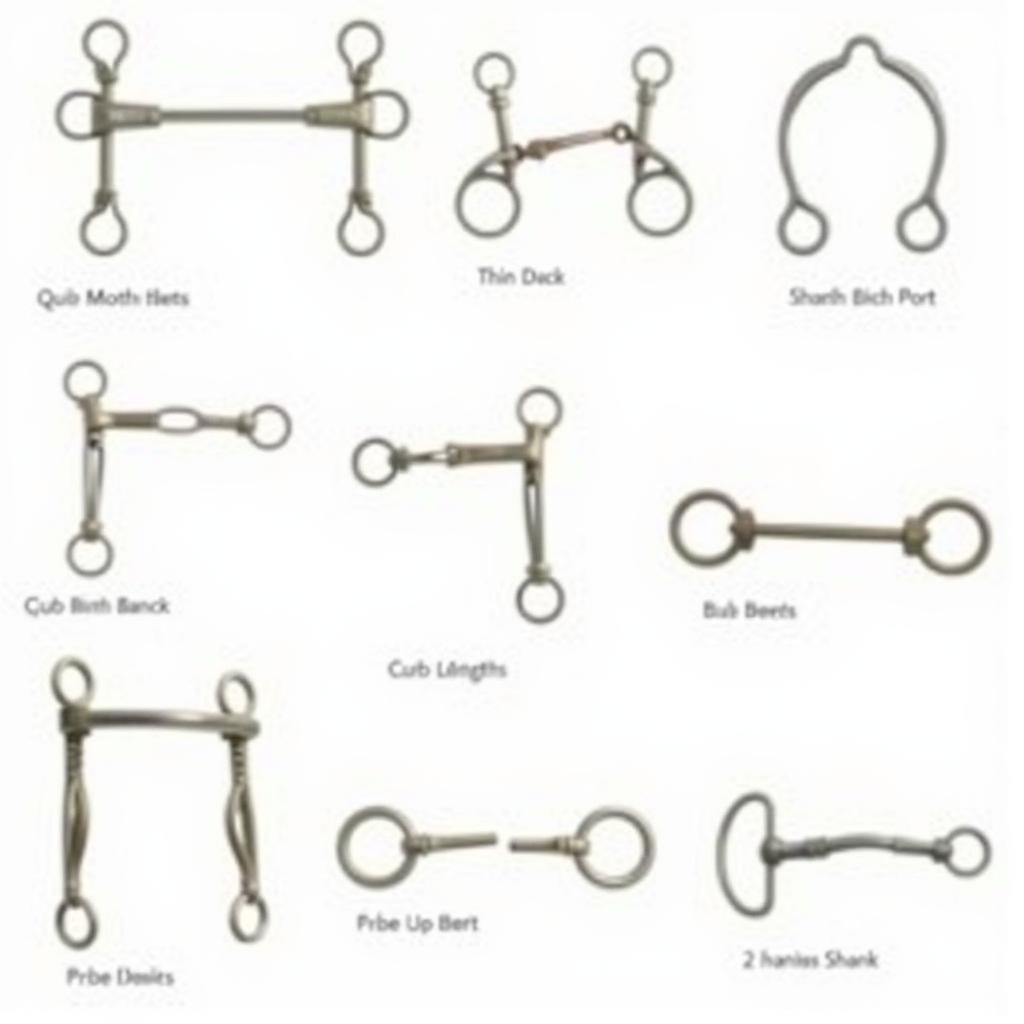Quick Horse Bits are often misunderstood tools in the equestrian world. Their effectiveness hinges on proper usage and a deep understanding of how they interact with a horse’s sensitive mouth. Choosing the right bit for your horse requires careful consideration of their individual needs and training level, as well as the intended riding discipline. Let’s explore the intricacies of quick horse bits and learn how to use them responsibly.
A horse’s mouth is incredibly sensitive, containing a complex network of nerves and tissues. round hay feeder for horses A quick horse bit, characterized by its direct and rapid action, can easily become a source of discomfort or even pain if used incorrectly. It’s essential to recognize that these bits aren’t inherently harsh, but rather, their efficacy and humaneness depend entirely on the rider’s hands.
Types of Quick Horse Bits
There are several variations of quick horse bits, each designed with specific features that influence their action and severity. Understanding these nuances is crucial for selecting the appropriate bit for your horse.
Snaffle Bits with Quick Action
While not traditionally considered “quick” bits, certain snaffle bit designs can deliver a more direct rein aid. Thinner mouthpieces, for instance, concentrate pressure on a smaller area, resulting in a quicker response. Similarly, single-jointed snaffles can create a nutcracker effect, which some horses find uncomfortable.
Curb Bits and Leverage Action
Curb bits, with their shanks and leverage action, are often categorized as quick bits. The length of the shank dictates the degree of leverage and consequently, the speed and intensity of the rein aid. Longer shanks amplify pressure, making the bit’s action quicker and more pronounced.
 Different Types of Quick Horse Bits
Different Types of Quick Horse Bits
When Are Quick Horse Bits Appropriate?
The suitability of a quick horse bit hinges on a number of factors, including the horse’s training level, the rider’s skill, and the specific riding discipline.
Experienced Horses and Riders
In skilled hands, quick horse bits can facilitate subtle communication and refined movements. Experienced riders can utilize these bits to deliver precise cues, allowing for greater control and responsiveness. However, even experienced riders must exercise caution to avoid inadvertently causing discomfort or pain.
Specific Disciplines
Certain riding disciplines may call for the use of quick horse bits. In disciplines requiring quick stops and turns, such as reining or cutting, these bits can be advantageous when used correctly. However, it’s crucial to prioritize the horse’s well-being and avoid using excessively harsh bits.
 Quick Horse Bits in Different Disciplines
Quick Horse Bits in Different Disciplines
Common Misconceptions About Quick Horse Bits
Many misconceptions surround the use of quick horse bits. One common misconception is that they are inherently cruel. While they can be misused, in the right hands, they can be effective tools for communication. Another misconception is that they are only for experienced riders. While experience is certainly beneficial, a novice rider with proper guidance can learn to use these bits responsibly. hay nets horses
Choosing the Right Quick Horse Bit
Selecting the appropriate quick horse bit requires careful consideration of your horse’s individual needs and your riding style.
Consider Your Horse’s Mouth Conformation
Horses with sensitive mouths may benefit from bits with softer mouthpieces, such as those made of rubber or flexible materials. Horses with low palates may require bits with a port to prevent pressure on the roof of their mouth.
Factor in Your Riding Discipline
Different disciplines have varying bitting preferences. For example, western riding often utilizes curb bits, while English riding may favor snaffle bits or combination bits.
Seek Professional Guidance
Consulting with a qualified equine professional, such as a trainer or veterinarian, can provide valuable insights into selecting the right bit for your horse. They can assess your horse’s mouth conformation, riding style, and training level to recommend the most suitable option.
Conclusion
Quick horse bits can be valuable tools when used correctly and responsibly. Understanding their action, choosing the appropriate type for your horse, and prioritizing proper training are essential for ensuring their effective and humane use. By focusing on clear communication and gentle guidance, we can establish a harmonious partnership with our equine companions.
FAQs
- Are quick horse bits cruel? No, not inherently. Their effectiveness and humaneness depend on the rider’s skill and understanding.
- What are the different types of quick horse bits? Common types include curb bits, snaffles with thin mouthpieces, and combination bits.
- When should I use a quick horse bit? Consider your horse’s training, your experience, and the riding discipline.
- How do I choose the right quick horse bit? Factor in your horse’s mouth conformation, riding discipline, and seek professional advice.
- Why is it important to use quick horse bits responsibly? Misuse can cause discomfort and damage to your horse’s sensitive mouth.
- What are some common misconceptions about quick horse bits? One is that they’re inherently cruel, another is that they’re only for advanced riders. best hay net for horses
- Where can I get more information about quick horse bits? Consulting an equine professional can provide personalized guidance.
If you need further assistance, please contact us at Phone Number: 0772127271, Email: [email protected], or visit our address: QGM2+WX2, Vị Trung, Vị Thuỷ, Hậu Giang, Việt Nam. We have a 24/7 customer service team.